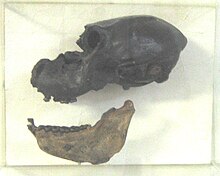Paralouatta
| Paralouatta Temporal range: Early Miocene-Quaternary
| |
|---|---|

| |
| Paralouatta marianae skull | |
| Scientific classification | |
| Domain: | Eukaryota |
| Kingdom: | Animalia |
| Phylum: | Chordata |
| Class: | Mammalia |
| Order: | Primates |
| Suborder: | Haplorhini |
| Infraorder: | Simiiformes |
| Family: | Atelidae |
| Subfamily: | Alouattinae |
| Genus: | †Paralouatta Rivero & Arredondo 1991 |
| Type species | |
| †Paralouatta varonai Rivero & Arredondo 1991
| |
| Species | |
| |
Paralouatta is a platyrrhine genus that currently contains two extinct species of small primates that lived on the island of Cuba.
Description
[edit]Paralouatta varonai was described from a nearly complete cranium from the late Quaternary in 1991. This cranium and a number of isolated teeth and postcranial bones were found in the Cueva del Mono, a cave site in Pinar del Río Province. The initial description of the cranium included a proposal that Paralouatta varonai was a close Caribbean relative of the extant Alouatta (howler monkeys) of Central and South America,[1] but this taxonomic placement was called into question with the analysis of the dental remains.[2] Based on shared similarities with the three other Caribbean monkeys, Xenothrix mcgregori, Insulacebus toussaintiana, and Antillothrix bernensis, MacPhee and Horovitz have proposed that the Caribbean primates are part of a monophyletic radiation which entered the Caribbean at the Oligocene–Miocene boundary. Further research confirms this assessment and places these three species in the tribe Xenotrichini.[3] However, more recent research restores its close relationship with Alouatta.[4] The postcranial morphology of Paralouatta suggests that it was partly terrestrial,[5] and a likely example of island gigantism.[6]
A second species of Paralouatta (P. marianae) has also been described from the Burdigalian (~18 million years old) Lagunitas Formation and is the largest Neotropic primate known of that epoch.[6]
Paleobiology
[edit]Paralouatta had an estimated body mass of 8.4 kg (19 lb).[4] Analysis of postcranial morphology suggests that Paralouatta was at least somewhat semi-terrestrial, making it the most terrestrial platyrrhine genus known.[7]
References
[edit]- ^ Rivero, M. & Arredondo, O. (1991). "Paralouatta varonai, a new Quaternary platyrrhine from Cuba". Journal of Human Evolution. 21 (1): 1–11. Bibcode:1991JHumE..21....1R. doi:10.1016/0047-2484(91)90032-Q.
- ^ Horovitz, I. & MacPhee, R.D.E. (1999). "The quaternary Cuban platyrrhine Paralouatta varonai and the origin of the Antillean monkeys". Journal of Human Evolution. 36 (1): 33–68. Bibcode:1999JHumE..36...33H. doi:10.1006/jhev.1998.0259. PMID 9924133.
- ^ MacPhee, R.D.E. & Horovitz, I. (2004). "New Craniodental Remains of the Quaternary Jamaican Monkey Xenothrix mcgregori (Xenotrichini, Callicebinae, Pitheciidae), with a Reconsideration of the Aotus Hypothesis". American Museum Novitates (3434): 1–51. doi:10.1206/0003-0082(2004)434<0001:NCROTQ>2.0.CO;2. S2CID 86051925.
- ^ a b Silvestro, Daniele; Tejedor, Marcelo F.; Serrano Serrano, Martha L.; Loiseau, Oriane; Rossier, Victor; Rolland, Jonathan; Zizka, Alexander; Antonelli, Alexandre; Salamin, Nicolas (2017). "Evolutionary history of New World monkeys revealed by molecular and fossil data" (PDF). BioRxiv: 1–32. Retrieved 2019-02-20.
- ^ Püschel, Thomas A.; Marcé-Nogué, Jordi; Gladman, Justin; Patel, Biren A.; Almécija, Sergio; Sellers, William I. (2020). "Getting Its Feet on the Ground: Elucidating Paralouatta's Semi-Terrestriality Using the Virtual Morpho-Functional Toolbox". Frontiers in Earth Science. 8: 79. Bibcode:2020FrEaS...8...79P. doi:10.3389/feart.2020.00079. ISSN 2296-6463.
- ^ a b MacPhee, R.D.E.; Iturralde-Vinent, M.A. & Gaffney, E.S. (February 2003). "Domo de Zaza, an Early Miocene Vertebrate Locality in South-Central Cuba, with Notes on the Tectonic Evolution of Puerto Rico and the Mona Passage". American Museum Novitates (3394): 1–42. doi:10.1206/0003-0082(2003)394<0001:DDZAEM>2.0.CO;2. hdl:2246/2820. S2CID 55615855.
- ^ Püschel, Thomas A.; Marcé-Nogué, Jordi; Gladman, Justin; Patel, Biren A.; Almécija, Sergio; Sellers, William I. (2020). "Getting Its Feet on the Ground: Elucidating Paralouatta's Semi-Terrestriality Using the Virtual Morpho-Functional Toolbox". Frontiers in Earth Science. 8. Bibcode:2020FrEaS...8...79P. doi:10.3389/feart.2020.00079. ISSN 2296-6463.




